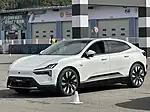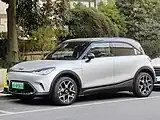| Sustainable Experience Architecture (SEA) | |
|---|---|
.jpg.webp) Zeekr 001, the first vehicle to use the Sustainable Experience Architecture platform | |
| Overview | |
| Manufacturer | Geely Holding |
| Production | 2021–present |
| Body and chassis | |
| Layout |
|
The Sustainable Experience Architecture (SEA; Chinese: 浩瀚; pinyin: Hàohàn) platform is a modular electric vehicle platform developed by Geely Holding. The platform is planned to be deployed to Geely Holding portfolio brands along with the Smart joint venture with Daimler AG.[1]
Geely refers the SEA platform as "open-source," meaning the manufacturer is open to supply the platform to other automakers.[2] Geely Holding has claimed it has entered into preliminary discussions with other manufacturers about potential use of the SEA platform.[3]
Overview
The SEA platform is more of an architecture that unifies multiple platforms covering almost all vehicle types. The platform will consist of five different core versions covering a variety of market segments:[4]
- SEA1 (previously PMA1) for E Executive cars with wheelbase of 3,000 mm to 3,019 mm
- SEA2 (previously PMA2) for D Compact executive cars with wheelbase of 2,900 mm
- SEA-E (SEA Entry) for C Compact cars with wheelbase of 2,750 mm
- SEA-S (previously EPA for Electric Premium Architecture) for S sports cars
- SEA-C (SEA Commercial) M for Commercial vehicles between 3.5 and 5.5 tonnes, including trucks, vans, and buses.
Each core platform will further be available in several different variants such as front, rear, and all-wheel drive, as well as single, double, and triple motor configurations.[5] Performance is expected to be competitive, with support for both 400V and 800V architectures, fast charging, and 0-60 acceleration times as low as three seconds.[6]
The predecessor of SEA platform is Geely's pure electric vehicle platform PMA. According to Geely's plan for the SEA architecture, the PMA platform was split into two variants in the later phase with the PMA1, now renamed SEA1, used in medium and large vehicles such as the Zeekr 001, and PMA2, now renamed SEA2, used in small and compact vehicles such as Smart #1.[7]
The first model based on the SEA architecture is the Zeekr 001 (unveiled on 23 September 2019 as the Lynk & Co Zero Concept) and is being launched in 2021.[8]
SEA OS is the software component of the SEA platform.[9][10]
On 5 September 2021, Geely and Mercedes-Benz Group announced the Smart Concept #1 based on SEA, and due in 2022.[11]
Jidu Auto, a joint venture between Geely and Baidu, intends to use SEA for a full portfolio of vehicles in different segments, starting in 2022.[12]
Models
SEA1
- Ji Yue 01 (2022)
- Polestar 4 (2023)
- Polestar 5 (2024)
- Volvo EM90 (2024)
- Zeekr 001 (2021)
- Zeekr 009 (2022)[13]
 Ji Yue 01
Ji Yue 01 Polestar 4
Polestar 4 Polestar 5
Polestar 5 Volvo EM90
Volvo EM90.jpg.webp) Zeekr 001
Zeekr 001 Zeekr 009
Zeekr 009
PMA2+
- Zeekr 007 (2023)
 Zeekr 007
Zeekr 007
SEA-E
- Smart #1 (2022)
- Smart #3 (2023)
- Volvo EX30 (2023)
- Zeekr X (2023)
 Smart #1
Smart #1 Smart #3
Smart #3 Volvo EX30
Volvo EX30.jpg.webp) Zeekr X
Zeekr X
EPA
- Lotus Eletre (2022)
- Lotus Emeya (2024)
 Lotus Eletre
Lotus Eletre.jpg.webp) Lotus Emeya
Lotus Emeya
SEA-C
- Radar RD6 (2022)
.jpg.webp) Radar RD6
Radar RD6
References
- ↑ R, Anjan. "Geely SEA platform to spawn Smart Electric SUV & A-segment model". topelectricsuv.com. Retrieved 2021-02-24.
- ↑ "Geely previews EV modular platform destined for future Volvos". Motor Authority. Retrieved 2021-02-24.
- ↑ "Geely Has Big Plans For Its New SEA EV Platform". InsideEVs. Retrieved 2021-02-24.
- ↑ "Geely SEA EV architecture detailed – 5 versions to cover all sizes, including sports cars and pick-ups - paultan.org". Paul Tan's Automotive News. 2021-06-18. Retrieved 2021-08-19.
- ↑ "Geely Has Big Plans For Its New SEA EV Platform". InsideEVs. Retrieved 2021-08-19.
- ↑ "Geely Has Big Plans For Its New SEA EV Platform". InsideEVs. Retrieved 2021-08-19.
- ↑ "Electric Smart, is it really an extremely krypton blood relative?". inf.news. Retrieved 2022-04-08.
- ↑ "Geely's New SEA Electric Vehicle Platform To Underpin A Range Of Models". Carscoops. 2020-09-25. Retrieved 2021-02-24.
- ↑ "重金打造SEA浩瀚架构,吉利的野心绝不仅仅是一个平台". www.sohu.com. Retrieved 2023-09-23.
- ↑ "5 key insights into Geely's new SEA electric car platform".
- ↑ "Smart Concept #1 Arrives In Munich As Not-So-Small Electric Crossover". Motor1.com. Retrieved 2021-09-06.
- ↑ "Jidu Auto to invest billions in electrification by 2026". electrive.com. 2021-04-27. Retrieved 2021-09-24.
- ↑ Feijter, Tycho de (2022-08-09). "Zeekr 009 Is A New Electric MPV For The Chinese Car Market". CarNewsChina.com. Retrieved 2022-08-10.